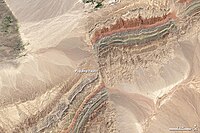
Photo from wikipedia
Abstract Using wet kaolin experiments, we document the evolution of strain localization during strike-slip fault maturation under variable boundary conditions (pre-existing fault, depth of and distribution of basal shear). While… Click to show full abstract
Abstract Using wet kaolin experiments, we document the evolution of strain localization during strike-slip fault maturation under variable boundary conditions (pre-existing fault, depth of and distribution of basal shear). While the nature of the basal shear influences strain localization observed at the clay surface, similarities between experiments reveal a general conceptual model of strain accommodation. First, shear strain is accommodated as distributed shear (Stage 0), then by development of echelon faults (Stage I), then by interaction, lengthening and propagation of those echelon faults (Stage II) and, finally, by slip along through-going fault (Stage III). Stage II serves as a transitory period when the system reorganizes after sufficient strain localization. Here, active fault system complexity is maximized as faults link producing apparent rotation of active fault surfaces without material rotation. As the shear zone narrows, off-fault deformation decreases while fault slip and kinematic efficiency increases. We quantify kinematic efficiency as the ratio of fault slip to applied displacement. All fault systems reach a steady-state efficiency in excess of 80%. Despite reducing off-fault deformation, the through-going fault maintains
Journal Title: Journal of Structural Geology
Year Published: 2017
Link to full text (if available)
Share on Social Media: Sign Up to like & get
recommendations!